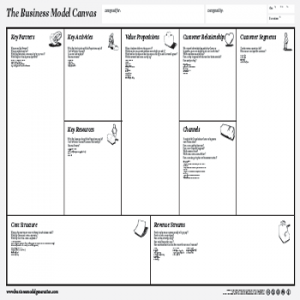Here lies the business plan. Once integral to every new business, it’s now been reduced to a cold, lifeless body on a mortician’s table. Who delivered the killing blow? The business model canvas, of course. How? Let’s take a look.

For a long time, business plans were considered essential to the development of any new business. Typically 20-40 pages long, the document sets out a business’ objective and lists out strategies that could be adopted to achieve them.
Therein lies the business plan’s first fatal flaw: it attempts to predict the future. In an article for inc.com, entrepreneur Steve Blank said, “Entrepreneurs often mistake their business plan as a cookbook for execution, failing to recognize that it is only a collection of unproven assumptions.” Soon-to-be entrepreneurs often rely too heavily on the assumptions made in a business plan. It is impossible to predict the future, so a plan can’t be set in stone. While business plans aren’t intended to be followed word-for-word, they often aren’t dynamic enough to keep up with rapidly changing market conditions.
Business plans’ second hamartia is the fact that they are too long. We’ve grown accustomed to articulating ourselves in 140 characters or less, sending and receiving 10-second-long disappearing videos and watching 2 minute videos instead of reading 5 page articles. Business executives want information delivered to them as quickly and concisely as possible. For better or worse, we simply don’t have the patience to read 40-page long business plans anymore.
Finally, business plans tend to place too much focus on results, partly through the heavy focus they place on projected income statements. A new venture is a means, not an end, according to an entrepreneur.com article by Martin Zwilling. Business plans often focus on the end goal of a business without considering key activities in depth. To quote Brigid Schulte, “You can’t think your way into a new way of acting, but you can act your way into a new way of thinking.”
What then led to business model canvases usurping the throne from business plans? In short, business model canvases – the brainchild of business theorist Alex Osterwalder – solve the issues associated with business plans presented above. They are dynamic, concise and place a strong focus on action. They are only one page long and can easily be updated to reflect changing market conditions.
Some might argue that the business plan is still alive and kicking. There are certainly entrepreneurs that do continue to use it. It remains to be seen how long business plans stick around for, but in my mind, there is no doubt: business plans have lived long past their prime. Business model canvases are the way forward.

Word count: 442
References:
https://www.raconteur.net/business/death-of-a-business-plan
https://gocatalant.com/blog/the-business-plan-is-dead-here-is-what-to-replace-it-with
https://www.inc.com/steve-blank/startup-owners-manual-customer-development-rules.html
https://steveblank.com/category/business-model-versus-business-plan/
https://www.entrepreneur.com/article/229804
Picture: https://canvanizer.com/new/business-model-canvas
Picture: http://moziru.com/explore/Drawn%20tombstone/
https://nomorestartupmyths.com/the-death-of-the-business-plan-and-the-successor/